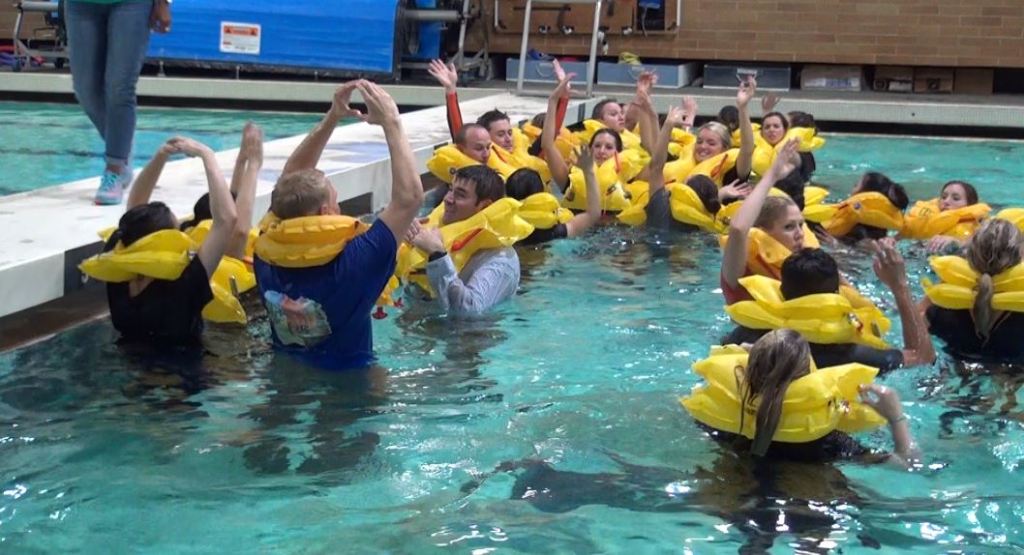Behind the scenes: Alaska Airlines’ flight attendant training
Share

It’s more than serving sodas and hot meals – when Alaska Airlines’ flight attendants take to the skies they are ready to fight fires, save lives and take on any obstacle. In fact, learning to serve customers in flight only accounts for a fraction of the six-week training every new Alaska flight attendant goes through.
Prospective flight attendants apply online and if they are selected, move on to a phone interview. After passing the phone interview candidates continue on to an in-person interview. The face-to-face interview can last up to 12 hours and covers everything from their personality to if they’re willing to take on intensive training and a demanding job.
“I think we’re different,” says flight attendant Luci Abbrederis who is an active member in the training program. Abbrederis says Alaska Airlines has a culture and she looks for applicants who will fit it.
“We’re the kind of people here that whether you’re at Target and someone asks you where the bicycles are or you’re driving down the road and someone needs gas, we stop,” says Abbrederis. “We’re the kind of people that help.”
By the end of the face–to-face interview day, applicants know whether or not they’ve made the cut. If they demonstrate all the qualities Alaska looks for in an attendant, they advance to a rigorous six week training course.

“New hires learn how to keep customers safe in an unexpected situation,” says Megan Brown, a member of the flight attendant training team. “They learn a variety of skills, ranging from defending themselves in a hijacking, to delivering a baby or restraining an out-of-control customer.”
Brown chose to work at Alaska because she appreciated the “safety first” culture.
“I wasn’t doing a lot of traveling and I didn’t quite have the knowledge base to know about the culture here,” says Brown. “I chose Alaska because we were safe. It was at a time that you heard about accident after accident on the news and Alaska was known for being safe.”
When they graduate, flight attendants are part customer service agent, firefighter, nurse and rescue crew.
Students train in a simulated plane that looks and functions like a real aircraft – minus the flying. Drills, emergencies and customer service are all simulated in the training room and trainees learn to evacuate a plane, use an emergency slide and wrangle an irate customer.
During training, the students get a “water day” where they go to a local pool and, fully dressed from head to toe, practice water survival techniques. The pool simulates a water landing and an arctic survival drill where students need to work together to get on rafts and preserve body heat.
Trainees also spend time in the air getting to work alongside current flight attendants for on-the-job experience. Once a week, throughout the six-week-training, students work flights and serve customers as if they’ve already graduated.
Most flight attendants will never have to use the majority of their training, but you’ll never feel safer than when you are with an Alaska Airlines flight attendant.




Comments
Best Customer Service! On a recent flight from Burbank to Anc via Sea, I witnessed a flight attendant named Molly on her knees searching through a full trash bag. Only minutes later, I see that she found a retainer thrown by a young boy. Above and beyond the call of duty!
On a trip via Alaska Airlines I witnessed first hand how flight attendants react to an emergency.
While sitting in First Class on a flight from Seattle to Anchorage, a gentleman sitting across the isle suffered a heart attack. Wow, the crew took control, contacting medical staff in Arizonia via air phone and receiving instructions as to how to care for him.
They requested for any doctors on board to come forward and two did. The flight continued on to Anchorage as we were about 1 hour out. The gentleman was taken off the plane in a wheel chair
and greeted all with a smile as we deplaned. Great Job crew.
Another time several years ago I was late for the Alaska Air plane departing Cabo San Lucas, B.C.
As I and another gentleman stepped out of the terminal, The plane’s door was shut and steps retracted ( at that time in Cabo one used stairs to get on board) engines running. When the pilot saw us, he opened the little cockpit window and waived us out to board. He shut down the left engine and the cabin crew opened the door and lowered the stairs., We got on board and were very thankful to the pilot and crew.
Alaska Air is the only way to go.
Alaska Airlines has always been my “flight of choice.” Their planes always seen to be well taken care of and safe, as well as pilots who know how to take off and land, but I had no idea about this flight attendants training program..I,m very impressed and it gives me one more reason to fly Alaska.. FROM GERALDINE KOPE…..GO ALASKA!!!
We are die hard Alaska Airline customers and will gladly pay a little extra to fly Alaska over other airlines because of their customer service. Years ago when my husband passed out on a flight from Anchorage to Vegas, they not only took excellent care of him but comforted me immensely. When we got off the plane one of the flight attendants told me she had never dealt with a life/death situation like that before but we never knew that at the time as they remained calm and did what they had to do. Thanks Alaska Airlines for providing such great training and selecting such awesome people to work for you.
Alaska airlines is my go to airline. Wherever I need to go, my first choice will always be Alaska airlines. They have the most awesome flight attendants. Their entire group of employees fit the bill. Keep up the good work!!
Comments are closed.